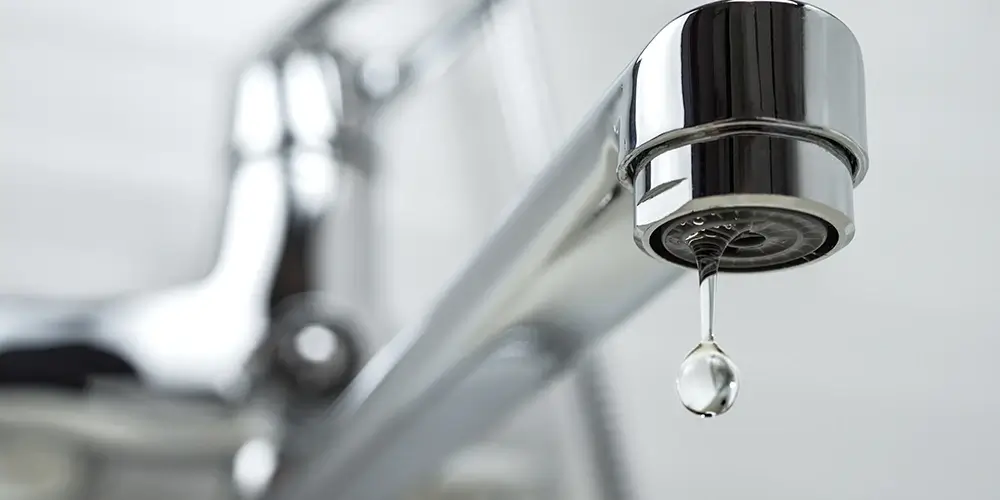Faucet drips contribute to up to 10,000 gallons of water waste per residence every year.
That’s enough water to fill a small to medium-sized swimming pool and to hydrate approximately 40,000 gym sessions. It certainly adds up.
Some faucet repairs, especially those involving complex fixtures, necessitate a professional repair. But most leaky faucets can be fixed DIY without too much fuss.
Common Causes of Dripping, Leaky Faucets
1. Corroded Valve Seat
- The valve seat is part of the compression mechanism. It’s a connecting structure between the spout and the faucet.
- Sediment can accumulate in the valve seat, causing corrosion and leaks around the spout.
- Regular cleaning can prevent this issue.
2. Worn Out Washer
- The washer is a small, round piece of rubber or plastic that creates a watertight seal.
- Washers experience friction and deterioration during use.
- When they get too worn, water can seep through and cause drips.
3. Damaged O-Ring
- The O-ring is another component that can dry out, crack, or break due to regular use.
- It’s located near the faucet handle and helps hold the valve.
- When it gets damaged, leaks may appear around the handle area.
4. Loose Parts
- Various parts of the faucet may work their way loose over time.
- This includes screws, nuts, and other small components.
- Checking for loose parts should be part of regular maintenance to prevent leaks and drips.
5. Faulty Cartridge
- In cartridge faucets, the cartridge is responsible for controlling water flow.
- If it malfunctions, water may escape from the faucet.
- Replacing the cartridge will resolve the issue.
6. Old or Poor Quality Plumbing Fixtures
- Older and lower-quality fixtures are more prone to wear and tear.
- Upgrading to new and higher-quality fixtures will resolve the problem.
7. High Water Pressure
- Excessive water pressure can strain faucet components and lead to leaks.
- Homeowners can check their water pressure with a gauge and adjust it to prevent damage.
8. Incorrect Installation
- An improperly installed faucet may develop leaks.
- Follow the manufacturer’s instructions or hire a professional for installation.
DIY Steps to Fix a Dripping Faucet
Tools Needed
- Adjustable wrench
- Flathead and Phillips screwdrivers
- Needle-nose pliers
- Penetrating oil
- Replacement parts (washer and O-rings)
- Petroleum jelly
Compression Faucet
Replacing a Worn Washer
- Turn off the shut-off valve is turned off.
- Unscrew the tiny screws on the handle to take apart the unit. Sometimes the screws are hidden behind a metal or plastic disc.
- Use penetrating oil to loosen stuck screws.
- After removing the handle, inspect the faucet assembly.
- Remove the packing nut with an adjustable wrench or large pliers. Twist out the spindle by turning in the same direction as you would open the faucet.
- Remove the screw that keeps the washer in place. If the screw and stem are damaged, replace them.
- Use the right size and shape of replacement washer. If the old washer is beveled or flat, replace it with an identical shape.
- After replacing the old washer, reinstall the faucet assembly.
- Turn the stem clockwise to tighten it. Be careful not to damage the faucet’s metal.
Fixing a Corroded Valve Seat
If the faucet is still dripping after following the steps above, consider replacing the valve seat.
- Insert a seat wrench into the seat and turn it counterclockwise. Once the old seat is removed, you can replace it with an identical seat wrench.
- If the valve seat doesn’t budge, insert a seat sleeve in the location of the old seat to provide a tight seal.
- You can also use a grinder to even out the worn edges. Don’t use this tool excessively; it may grind too much of the seat.
Reinstalling a Loose Packing Nut
If the leak occurs when the faucet is turned on and water comes out of the handle, the packing nut is probably loose.
- Check if the packing nut is tight. Replace it if it’s loose. Avoid applying too much pressure and scratching the nut.
- Install the replacement packing nut. If the packing looks like a soft wire, wrap it around the stem once. If it has a string-like appearance, coil it around the stem several times.
- Before reassembling the faucet, apply a light coat of petroleum jelly on the packing nut and stem threads.
Replacing the O-ring
Kitchen faucets often have one or more O-rings to prevent water from seeping around the spout. If water comes out of this area every time you turn on the faucet, the ring is suspect.
- Remove the handle by unscrewing the screw that sets it in place.
- Take out the O-ring and replace it with a new one of the same diameter.
- Before reassembling everything, rub a light coat of petroleum jelly on the threads of the faucet stem to prevent leakage.
Cartridge Faucet
A cartridge faucet has a cartridge that regulates water flow and typically requires only a single handle for both temperature and flow control. Cartridge faucets tend to be easier to repair, as the cartridge can be replaced as a whole unit, while a compression faucet may have multiple parts that need replacement.
- Turn Off the Water Supply: Locate the shut-off valve under the sink and turn it off to prevent water from flowing during the repair.
- Remove the Faucet Handle: Depending on the model, you may need to unscrew the handle or pry off a decorative cap to access the screw beneath it.
- Take Out the Retaining Clip: If your cartridge faucet has a retaining clip, use pliers to gently remove it.
- Pull Out the Cartridge: Grip the cartridge firmly and pull it straight out of the faucet body. You may need to wiggle it slightly to loosen it.
- Inspect and Replace: Examine the old cartridge for wear or damage. Replace it with a new cartridge that matches the original specifications.
- Reinsert the New Cartridge: Slide the new cartridge into place, ensuring it’s seated correctly in the faucet body.
- Secure the Retaining Clip: If applicable, reattach the retaining clip to hold the cartridge in place.
- Reattach the Faucet Handle: Place the handle back on the faucet and reattach any screws or caps,
- Turn the Water Supply Back On: Turn the shut-off valve back on and check for leaks.
Tips for Preventing Faucet Leaks
- Schedule regular maintenance checks for your faucets and other plumbing fixtures.
- Look for signs of wear and tear on faucet components.
- Address small leaks promptly before they turn into bigger problems.
- Install water-saving aerators on your faucets to reduce water flow and lower pressure on components.
- Don’t overtighten handles when turning them off. This can strain the faucet and lead to leaks.
- Hire a professional plumber for installations, repairs, and maintenance if you’re uncomfortable doing it yourself. While DIY fixes can save money, they may not always solve the problem.
FAQs: Repairing a Dripping Faucet
Q: How long will it take to fix a dripping faucet?
The time it takes to repair a dripping faucet depends on the cause of the leak and your level of experience. It could take anywhere from 30 minutes to an hour.
Q: Can I use any replacement parts for my faucet?
Use replacement parts recommended by the manufacturer for your faucet model. This ensures proper fit and function.
Q: Can I repair a faucet leak without turning off the water supply?
No. While repairing a faucet leak, it’s critical to turn off the water supply for safety and to prevent further damage.
Q: I tried fixing my faucet, but it’s still leaking. What should I do?
If your DIY fix didn’t work, call a professional plumber. The pros have the tools, expertise, and parts to diagnose and solve the issue.
Q: Can a faucet leak cause other plumbing problems?
If left unrepaired, even a small faucet leak can lead to bigger issues, such as water damage, mold growth, and higher water bills. Address any leaks promptly.
Q: How can I tell if my faucet needs new washers or cartridges?
If you notice persistent dripping or leaking after turning off the faucet or inconsistent water pressure, it may indicate that washers or cartridges need replacement.
Q: Is it necessary to replace the entire faucet if there is a leak?
Not necessarily. Many leaks can be repaired by replacing components like washers, cartridges, or O-rings. However, if the faucet is old or severely damaged, it may be cheaper to replace it entirely.
Q: What should I do if the faucet handle is stuck and won’t budge?
Apply penetrating oil to the screws and allow it to sit for several minutes. Gently tap the handle with a rubber mallet to help loosen it. Avoid using excessive force.
Q: Are there any environmentally friendly options for dealing with faucet leaks?
Installing a low-flow faucet aerator can reduce water waste, and prompt repairs help to conserve water.


